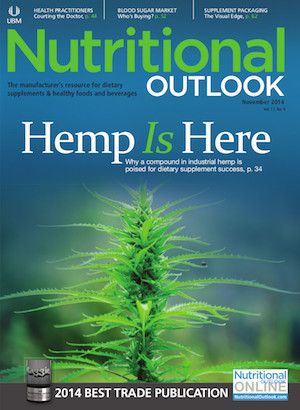Where Does the Multivitamin Stand These Days?
Nutritional Outlook interviews CRN's Judy Blatman on just where multivitamins stand these days.

Multivitamins have faced ups, downs, and “in between” over the years. On one hand, usage remains remarkably high. The Council for Responsible Nutrition’s (CRN; Washington, DC) annual Consumer Survey on Dietary Supplements ranks multivitamins as the most popular supplement consumed by U.S. adults; in fact, more than half of all American adults report taking one.
But recent studies-most evaulating multivitamin effects on chronic disease-and subsequent media reports have portrayed multivitamins negatively. Last December, an Annals of Internal Medicine editorial minced no words. The editorial, titled “Enough Is Enough: Stop Wasting Money on Vitamin and Mineral Supplements,” states: “The message is simple: Most supplements do not prevent chronic disease or death, their use is not justified, and they should be avoided. This message is especially true for the general population with no clear evidence of micronutrient deficiencies…”
A year earlier, researchers in the Physicians’ Health Study II, published in the Journal of the American Medical Association, found that taking a daily multivitamin did not reduce negative cardiovascular events, and a later-reported cognitive arm of the study found no cognitive benefits as a result of multivitamin supplementation.
Scientific bodies also remain equivocal, stating that, currently, there's not enough study evidence to demonstrate that multivitamins have benefits for Americans across the board.
So, on one hand, we have consumers obviously voting for multivitamins with their dollars; on the other, a scientific community that’s still not on board. What will it take for multivitamins to get a “yes” vote from all? Nutritional Outlook interviewed Judy Blatman, CRN’s senior vice president, communications.
Nutritional Outlook: Multivitamins have seen some negative press in recent years. The message that the dietary supplement industry maintains is that multivitamins (and supplements, in general) are meant to fill nutrient gaps and shore up general good health-not necessarily to prevent broad-scale disease. Has this message changed at all over the years? Is this still the primary argument supporting multivitamins?
Blatman: For as long as I can remember-and I’ve been at CRN for more than a dozen years-we have positioned the multivitamin as a safe, convenient, and affordable insurance policy for ensuring you are getting all your essential nutrients. But we’ve always positioned the multivitamin as a supplement to, not a substitute for, a healthy diet.
In terms of preventing broad-scale diseases with a simple multivitamin, I don’t think there’s ever been that expectation, but it stands to reason that if you’re getting the right nutrients, then your overall health will benefit because nutrition plays an important role in good health.
In response to the negative results of the cardiovascular and cognitive arms of the Physicians’ Health Study II, many media reports portrayed multivitamins negatively. Has the way the mainstream press interprets study results and draws conclusions about the benefits of multivitamins changed in any way over the years? Would you say that the messaging is more negative these days than it is positive, or vice versa?
Blatman: The mainstream media generally takes its cue from the medical journals and the way the study authors portray the results of their studies. That’s not unique to our industry.
The first negative wave of publicity that I experienced for the multivitamin was in 2006 following the National Institutes of Health Office of Dietary Supplements conference on the multivitamin and chronic disease where a scientific conference designed for a very specific purpose turned into a short-hand version of the conclusions. Some of the media got it right, but others couldn’t resist the temptation to turn that conference into a referendum on the multivitamin for all purposes.
We’ve seen a particularly bad cycle of press for supplements, including multivitamins, for the past year or two, and that’s had an impact, but I don’t think it will be a lasting one, as long as we continue to be proactive in our efforts to clean up the industry and listen and understand what consumers want in supplement products.
Overall, has multivitamin usage declined? And, if so, has multivitamin usage declined because more consumers are instead taking more specialized/variety of supplements? To balance this, has the usage of dietary supplements overall gone up?
Blatman: According to the CRN annual Consumer Survey on Dietary Supplements, overall usage of supplements has remained consistent, with approximately two-thirds of American adults taking them year after year.
As our country’s adult population increases, so has the actual number of American adults taking supplements. We’ve also seen good news in that regular usage has increased from 47% in 2005 to 53% in 2013, and regular users taking a variety of supplements has increased from 22% to 35% over that same period. And, according to our survey, the multivitamin is still the most popular vitamin, with more than half the adult population taking multis.
In CRN’s September 5, 2014, comments to the Dietary Guidelines Advisory Committee (DGAC), which is currently working to draft the 2015 Dietary Guidelines for Americans, CRN advocated a multivitamin-and supplements, in general-as a good way to fill nutrient gaps when those gaps aren’t met through food intake. The 2010 Dietary Guidelines for Americans stated that “Sufficient evidence is not available to support a recommendation for or against the use of multivitamin/mineral supplements in the primary prevention of chronic disease for the healthy American population.” What do you think are the chances that, this time around, the DGAC will recommend the use of a multivitamin?
Blatman: The Dietary Guidelines process is a complicated one, and CRN understands that process and respects the work of the Committee. We’re focusing on demonstrating where the evidence-based science for multivitamins exists, and we trust that the Committee will look seriously at the science.
At the most recent meeting of the DGAC, the Committee noted that people are not meeting recommended levels for certain letter vitamins, calcium, magnesium, and folate. As people struggle to get the nutrients they need, the multivitamin should be considered as one way to get those nutrients when diet alone doesn’t work.
We’re hopeful the Committee will expand its view of what constitutes nutrition, and focus on getting nutrients not only through conventional foods, but considering other delivery methods as well.
In their nutrient recommendations, the U.S. Preventive Services Task Force (USPSTF) and the 2010 Dietary Guidelines for Americans state that the evidence to support multivitamin usage on a broad scale is insufficient. What do you think will need to happen to ensure there is sufficient evidence to support multivitamin benefits for the wider U.S. population? More scientific research on multivitamins? Is enough research being done on multivitamins? And what is the outlook for multivitamins in the U.S. in terms of consumer acceptance and usage?
Blatman: What’s interesting is how the public policy recommendations have been misinterpreted. The USPSTF did not indicate that the research wasn’t supportive of multivitamin usage; it indicated there wasn’t enough research to make a recommendation either for or against usage of a multivitamin specifically for chronic disease. And while we wouldn’t suggest that multivitamins should be specifically taken for that purpose, the irony is there is actually some promising research on multivitamins and chronic disease. The Physicians’ Health Study II found some very real benefits for reducing the risk of cancer and cataracts in a well-nourished population.
I consider the multivitamin the foundation of good health in the supplement world. It’s still a safe, convenient, and affordable way to get our nutrients in one package, basically calorie-free, and certainly with the problems of obesity in this country, it’s an option that’s perfect for many Americans.
As an industry, we need to continue to be proactive, in terms of supporting well-designed science, telling our side of the story with the press and in online social and digital platforms, and separating those companies doing the right thing from those companies tarnishing our industry’s reputation. Consumers are smart and continue to look for ways to improve their health destiny-as an industry, we need to be nimble and help them find those products that will get them there.
Scientific bodies like the USPSTF focus on a scientific standard that is heavily weighted toward a drug-like evidence-based requirement-seeking several large drug-like RCTs in order to support a public health recommendation. CRN and others in the academic community have made some headway in differentiating evidence-based nutrition, and the need to look beyond drug-like RCTs when considering scientific standards for nutrients, but there’s still more to be done, particularly among scientists whose expertise is in conventional medical research. However, even as we try to change that mindset, we should still be supporting more well-designed research on the multivitamin.
Read more on why we need more science on multivitamins.
Jennifer Grebow
Editor-in-Chief
Nutritional Outlook magazine jennifer.grebow@ubm.com
Photo © iStockphoto.com/baurka

HHS announces restructuring plans to consolidate divisions and downsize workforce
Published: March 27th 2025 | Updated: March 27th 2025According to the announcement, the restructuring will save taxpayers $1.8 billion per year by reducing the workforce by 10,000 full-time employees and consolidating the department’s 28 divisions into 15 new divisions.
DOJ asks Utah court to dismiss FTC lawsuit against Xlear Inc.
March 11th 2025On March 10, the DOJ and the defendant filed a stipulation to dismiss with prejudice the lawsuit in which each party agrees “to be responsible for its own costs and fees and agrees that no party shall be responsible to any other party for any fines, costs, fees, or penalties arising from this case.”















